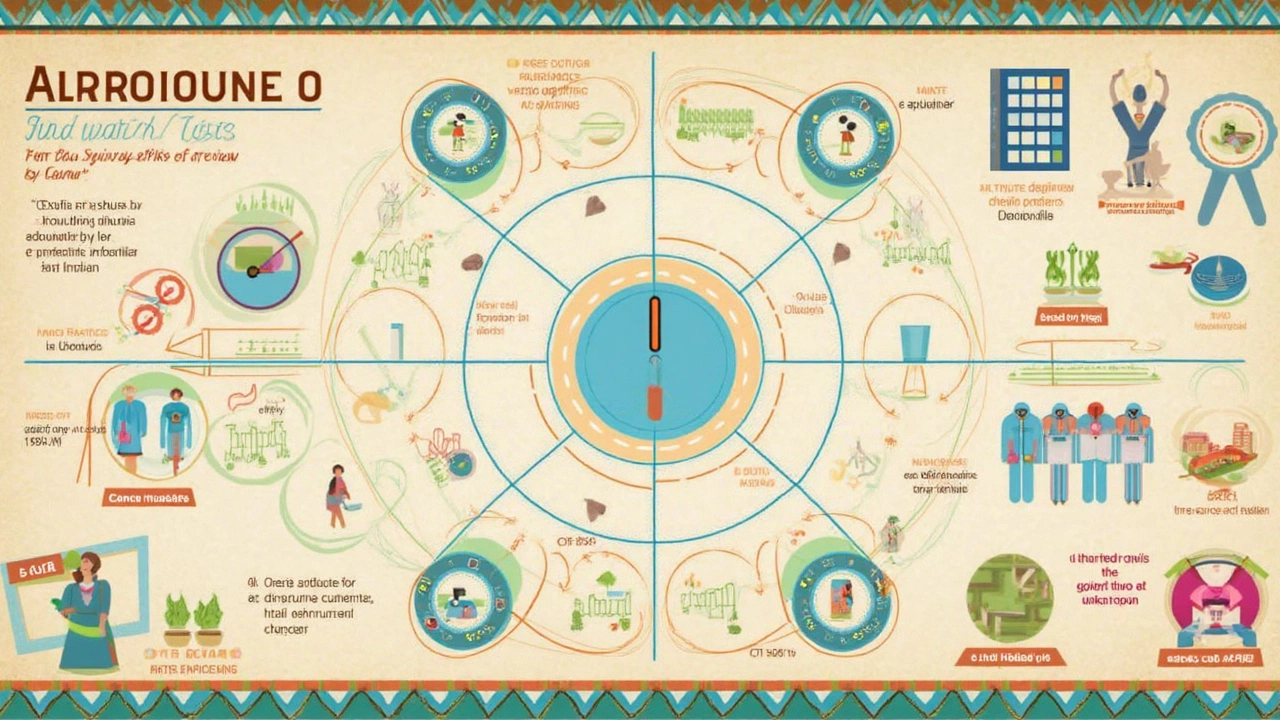If you've ever heard that cancer is a "life sentence," you might be surprised to learn just how outdated that idea is. The last couple of decades have flipped the script in ways most people don't realise. There’s no single answer for how long a cancer patient can live, and that's not just because cancer itself is complicated. It's because each person's body, story, attitude, and access to care are all tangled up in the answer. What makes things even wilder? Some people live decades with the disease—sometimes longer than folks with other chronic illnesses. Now, let's get into the weeds, bust some myths, and see what real numbers and people's stories look like these days.
What Affects Cancer Life Expectancy?
If only there was a calculator that spits out a number for everyone. But the truth? Life expectancy in cancer depends on a tangle of things—let's call them the big six. First, you've got the type of cancer. Some, like thyroid cancer, have 5-year survival rates over 95%. Others, like pancreatic cancer, can be tough—5-year rates hover under 10%. Second, the stage at diagnosis is a biggie. Cancers caught early (think stage I or II) can often be cured or held off for years. Advanced cancers (stage IV) have shorter averages, but there are the ultimate outliers who prove every statistic wrong.
Third, age and overall health matter. A 32-year-old marathoner will typically fare differently than an 82-year-old with heart issues. Genetics also play a tricky role—there's a reason why some families seem to get hit hard. Recent research even shows that certain gene mutations can mean more aggressive cancers, while others might actually help the body respond better to treatment. Treatment options are another piece. Access to surgery, newer targeted drugs, or immunotherapy can shift the odds. In the US, for instance, a study from the National Cancer Institute highlighted that 70% of early breast cancer patients lived over 15 years post-diagnosis, thanks mainly to advanced treatments.
Your attitude counts, too—don’t roll your eyes! People with strong support systems, who stay active, or keep fighting sometimes live longer. Indian oncologists even point out that folks who have family around them generally stick with treatment longer, and handle side effects better. Lifestyle plays a sneaky supporting role. Smokers with lung cancer typically have shorter life expectancies, but quitting—even after diagnosis—can give people extra months or years. Overweight patients with some cancers, like breast or colon, usually face more complications, but those who make nutrition tweaks and stay mobile often live longer. Other factors? Access to quality healthcare, stress management, mental health support, and geography. In cities like Bangalore or Mumbai, world-class cancer care is in reach. Rural patients may still face huge delays that affect outcomes.
Here's a useful table that puts actual numbers to some common cancers, based on the latest data from 2024 (source: American Cancer Society and Indian Cancer Society):
| Cancer Type | 5-Year Survival Rate (US) | 5-Year Survival Rate (India) |
|---|---|---|
| Thyroid | 98% | 85% |
| Breast (early stage) | 91% | 76% |
| Colon (all stages) | 65% | 51% |
| Lung (all stages) | 24% | 14% |
| Pancreatic | 12% | 7% |
| Leukemia (childhood) | 89% | 61% |
Doctors use averages when making predictions, but what matters more is how a patient responds, adapts, and what new treatments might arrive just in time. Takeaway: Numbers are a starting point, but rarely the final word.

Breakthroughs, Stories, and Real-World Survival
If you start searching online for "cancer survival stories," you’ll trip over stories like Anand, a Bengaluru techie who lived 12 years after a stage 4 colon cancer diagnosis, or Swapna from Hyderabad, who beat breast cancer twice and now runs half-marathons. It's wild, but thanks to medical progress, stories like theirs are becoming more common. The past decade has been packed with new drugs, smart ways of combining treatments, and rapid-fire genetic testing. For example, immunotherapy has allowed people with late-stage lung cancer—where five-year survival used to rarely hit double digits—to live six, seven, sometimes even ten years.
One interesting fact: For some advanced cancers, remission can last way longer than anyone guessed. There's the famous 2022 clinical trial out of Tata Memorial Hospital, Mumbai—where 53% of advanced lymphoma patients had "complete remission" even three years after their last treatment. These patients are now considered long-term survivors. That’s a huge shift from just a decade ago. Scientists now look at “survivorship” as its own thing, with late effects and quality of life as key issues, not just days on a calendar.
Did you know, about 1 in 4 people with incurable, late-stage cancers now live at least 2 years? Some double that. Coping with uncertainty is just a part of the journey. Doctors in India have started using a new term: "living with cancer." It means patients don’t just count lifespan, but fit as much living as they can into their days. The focus is on staying pain-free, eating better, and grabbing every medical option available. Survivorship clinics now operate in most big cities, with nutritionists, counselors, and exercise coaches who help keep patients active. One tip that’s gained a following: daily walks, even slow ones, keep chemo side effects at bay and improve mood, which can boost treatment success.
Still, there are tough cases. Take pancreatic or brain cancers—most stats say life expectancy is measured in months, not years. But the outliers keep showing up: the teacher who survived glioblastoma for eight years, the Delhi grandfather who passed a decade with advanced prostate cancer. There's a lesson here: predictions aren’t destiny. Even when the odds are stacked, some beat the clock with medical support, family, and sometimes pure luck.
If you or someone you care about is facing cancer, here’s a list of things that survivors say made a difference for them:
- Get a second opinion. Treatment options keep changing, and what was impossible two years ago could be on the table today.
- Don’t ignore mental health. Therapy, support groups, or even just confiding in a friend helps people push through the toughest weeks.
- Demand clarity from your doctor about test results and side effects. Notes, voice-recordings, or a trusted companion help reduce misunderstandings.
- Look for clinical trials—sometimes even free or subsidized by hospitals. New drugs and approaches might be available in cities like Bangalore or Chennai.
- Small, regular activity is better than extreme workouts. Thirty minutes of gentle walking five times a week can strengthen immunity.
- If money is tight, reach out to NGOs like the Indian Cancer Society—they help with treatment costs and transportation, often quietly.

Changing the Question: Focusing On Quality and Hope
When doctors get asked, "How much time do I have?" more and more are flipping the script: “How much life can we fit in now?” They’re not dodging. They just know too many stories that prove averages are just that—averages. Some people stretch odds with new therapies, positive attitude, or rock-solid family backing. In the last year, over 18% of terminal cancer patients in India actually outlived their doctors’ original estimates by at least six months. That’s not because of miracles, but good medical care, flexible treatments, and personalized nutrition and exercise.
You don’t have to hit the gym hard or give up every joy—one cancer survivor from Mumbai says her secret is lots of curd rice, daily calls with her sister, and WhatsApp memes. Sounds silly, but laughter and favourite food help more than strict diets for many patients. Another tip that comes up in survivor communities: take control where you can. Make schedules, plan outings, find new hobbies. People who do report fewer hospital days and more good days.
Even if you can’t cure your cancer, long-term survival means learning how to live with fewer symptoms and handling treatments like a pro. There are fresh ways to tackle pain and nausea—think cold caps for hair loss, scalp massage, peppermint oil, and yoga. In Bangalore, the palliative care movement has been huge, giving home care options so people don’t spend their last months in clinics. Caregivers, family, and friends can join training online or at local hospitals, picking up tips for feeding, cleaning, and cheering up loved ones at home. Simple changes—using bedside alarms, or sunlight in the room—can add comfort and calm.
Public attitudes are shifting, too. Events like “Cancer Conqueror Walks” in Indian cities and social media pages like Karunashraya's Survivor Stories are cutting isolation. People talk openly about planning, bucket lists, and sorting family affairs—much less taboo than even five years ago. A Bangalore support group found that patients who got peer support had 40% less depression and reported twice the number of “meaningful” days.
So, to answer the heart of the question—how long can a cancer patient live? There’s no fixed number, and that’s not a cop-out. Some go months, many go years, and a surprising number now reach old age with cancer just as “one more illness” they’re managing. What matters is the mix: cancer type, early detection, treatments, and those often-overlooked daily choices of attitude and support. If you made it this far, remember—numbers only tell part of the story. What you do with each day, surrounded by people who care, is where real living happens.
